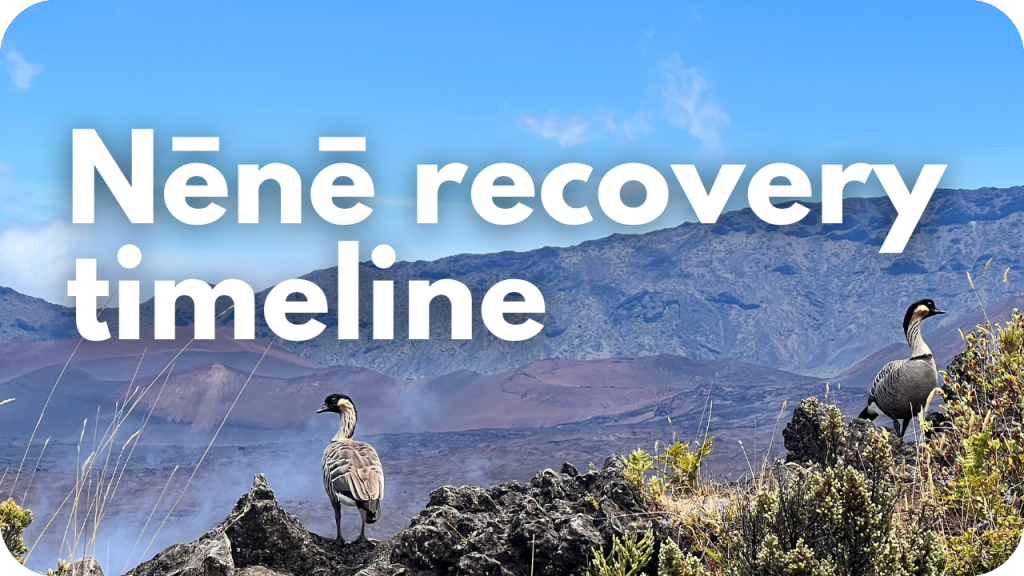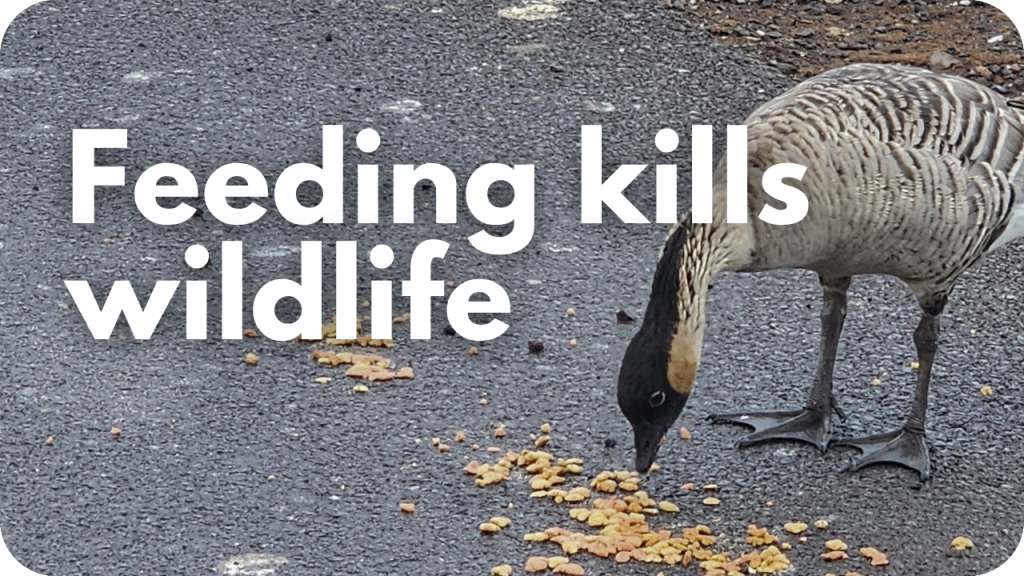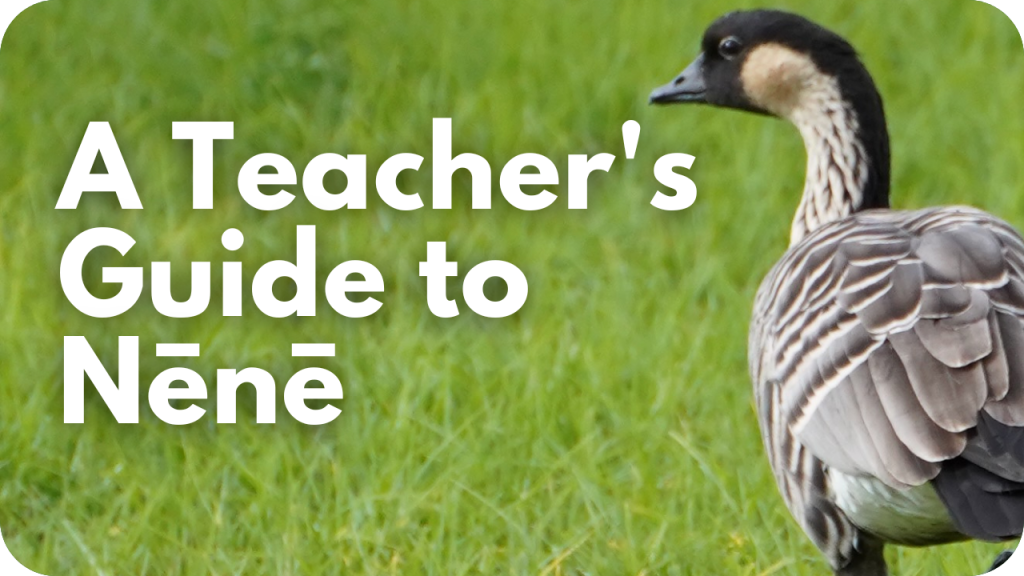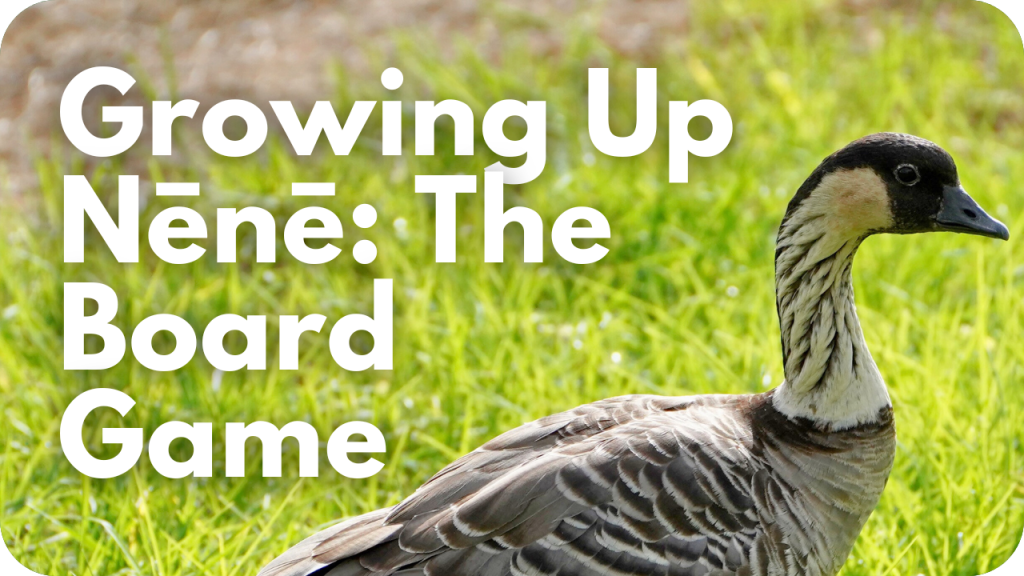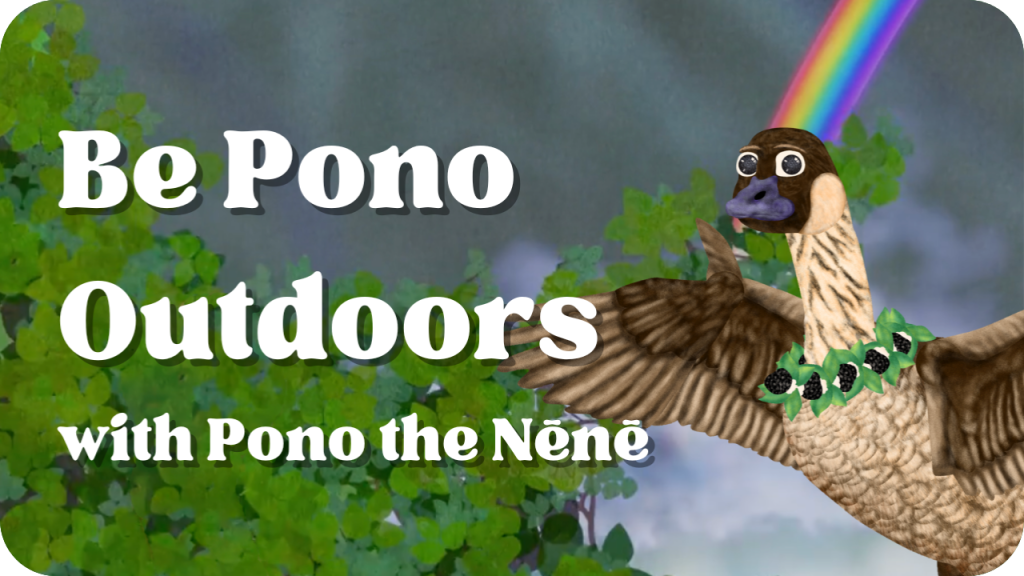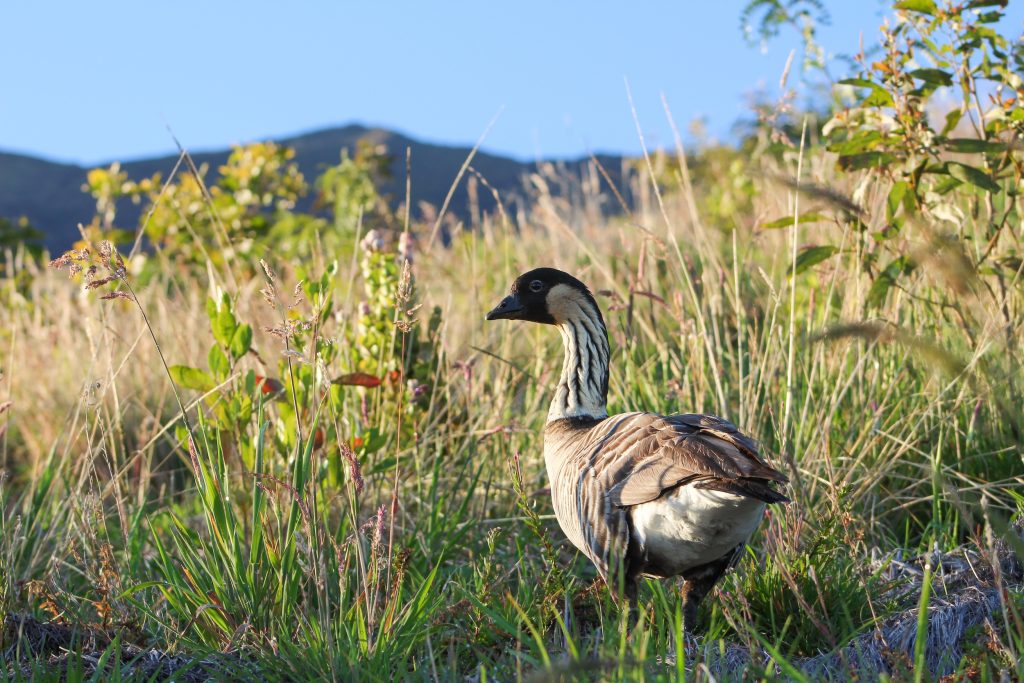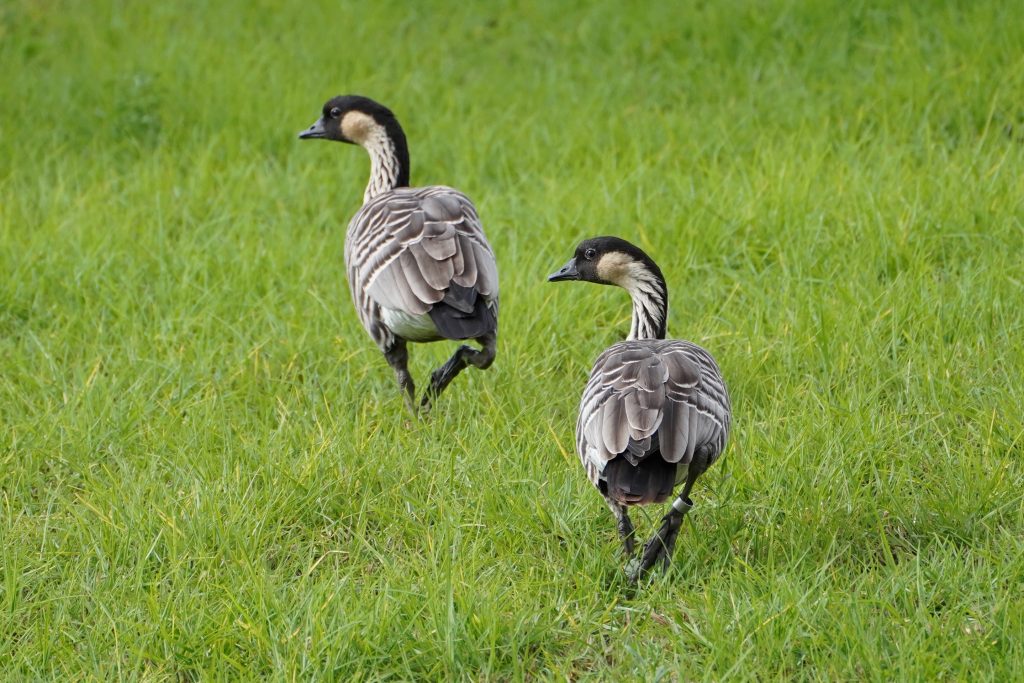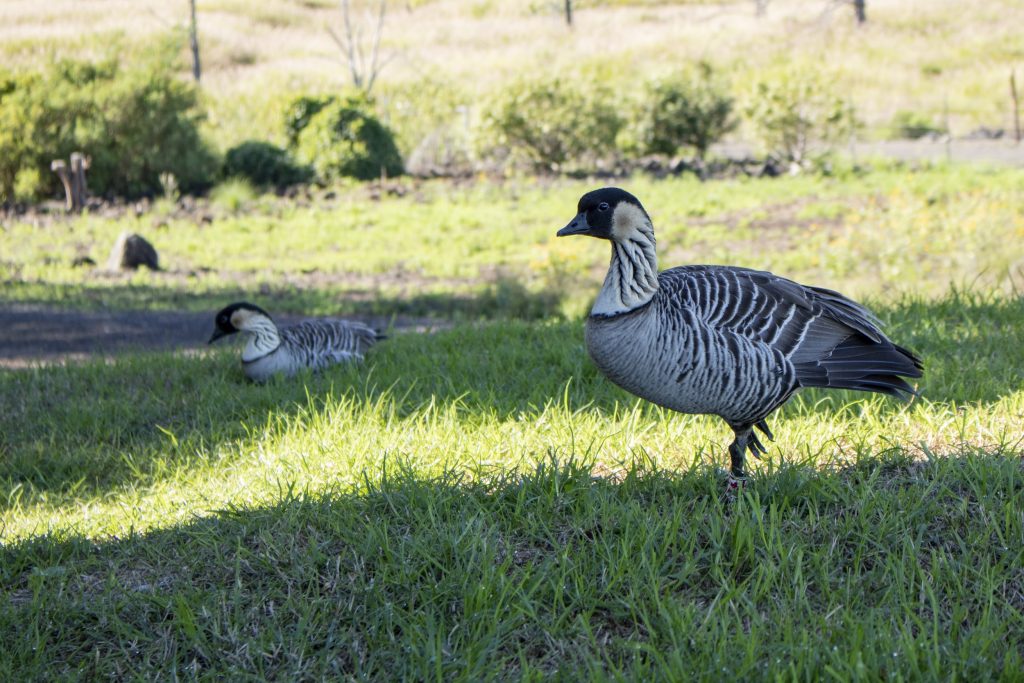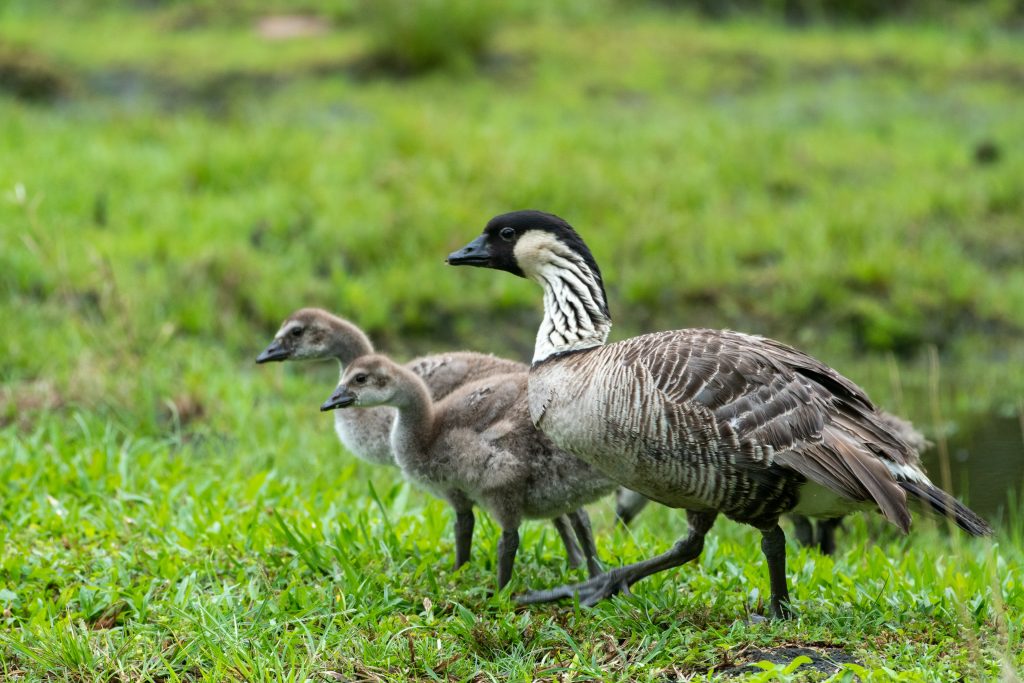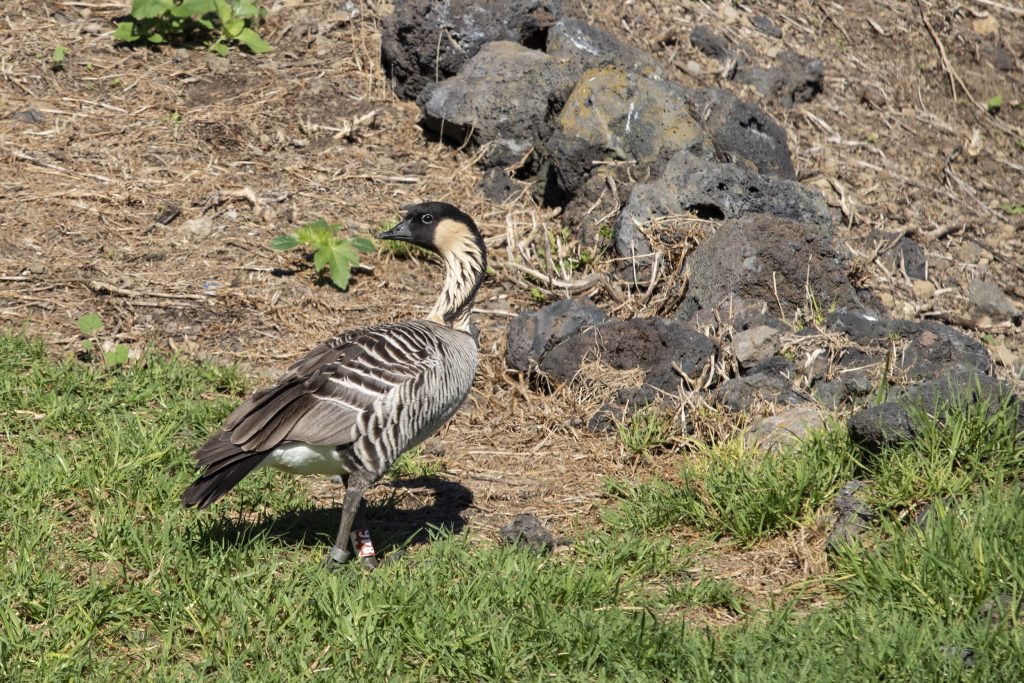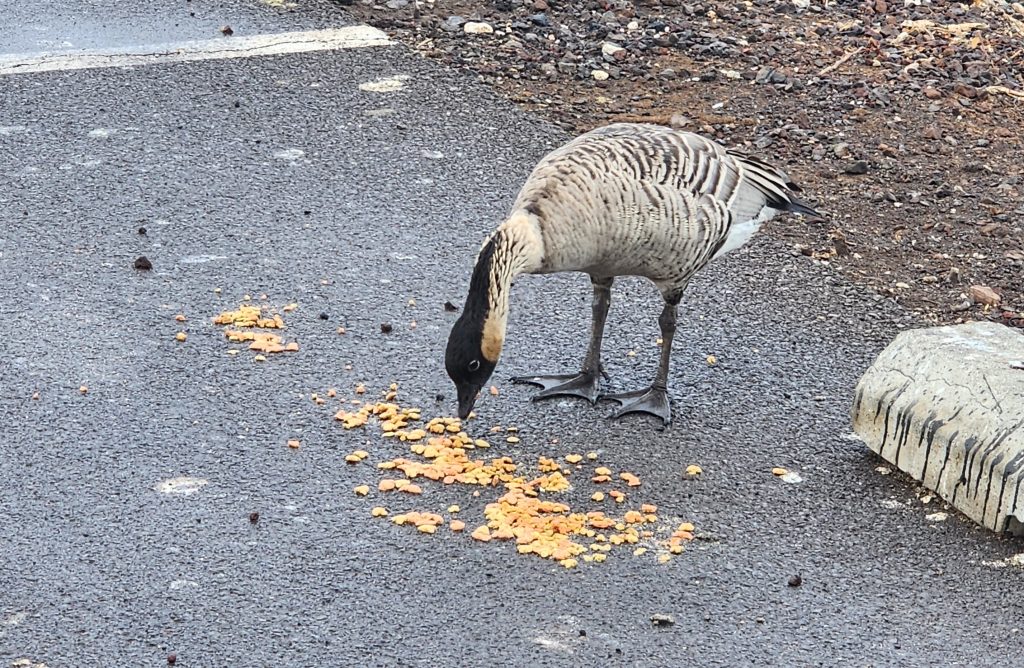Nēnē
Names
- Ōlelo Hawaiʻi: Nēnē
- Common: Hawaiian goose
- Scientific: Branta sandvicensis
Song
Conservation Status
- Federally Listed as Threatened
- State Listed as Endangered
- IUCN Red List Ranking – Vulnerable
Species Information
Historically, at least five species of geese occurred in Hawai‘i. Today, only the nēnē, or Hawaiian goose, survives. Adults are mostly dark brown or sepia with a black face and crown, cream-colored cheeks, and a pale yellow-to-white neck with black streaks. Females are smaller than males. Compared to other geese, nēnē are more terrestrial and have longer legs and less webbing between their toes, which likely facilitates walking on hardened lava.
Nēnē eat leaves, seeds, flowers, and fruits of at least 50 native and nonnative grasses, sedges, herbaceous plants, and shrubs. Diet varies by location and habitat, and they may require a diverse suite of food plants. Nēnē facilitate seed dispersal and play an important role in influencing the species composition of early successional plant communities. Nēnē should not eat human food or cat food. Do not feed nēnē, and do not leave cat food on the ground.
Historically, flocks moved between high-elevation feeding habitats and lowland nesting areas. Pairs mate for life and engage in relatively simple courtship displays in which the male attacks or threatens potential competitors, runs back to his mate, and calls loudly. Nēnē have an extended breeding season, and nesting may occur in all months except May, June, and July, although the majority of birds nest between October and March, and most clutches are laid between October and December. Nests consist of a shallow scrape lined with plant material and down. Breeding pairs usually return to the previous year’s nest site, typically in dense vegetation; when available, kīpuka may be preferred. Females lay two to five eggs, which hatch after 30 days. Young are hatched or born in an advanced state and are able to feed and move independently; however, they remain with their parents for up to a year.
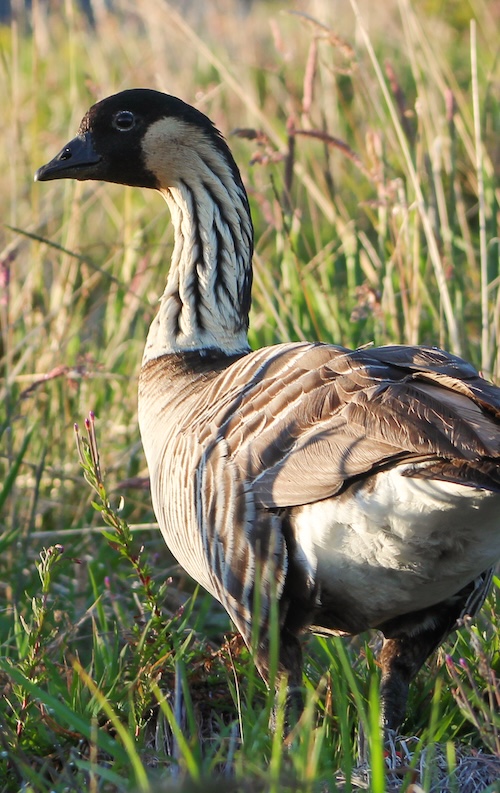
Distribution
Between sea level and 2,400 meters (7,800 feet) elevation on the islands of Hawai‘i, Maui, Kaua‘i, and Moloka‘i, and a single pair was reported on O‘ahu in 2014. Historically, the species was found on all Main Hawaiian Islands and was likely widespread.
Habitat
Nēnē historically occurred in lowland dry forest, shrubland, grassland, and montane dry forest and shrubland. Current habitat preferences are likely biased by the location of release sites of captive-bred birds. They currently use a wide variety of habitats, including coastal dune vegetation and nonnative grasslands (e.g., golf courses, pastures, rural areas), sparsely vegetated low- and high-elevation lava flows, midelevation native and nonnative shrubland, early successional cinderfall, cinder deserts, native alpine grasslands and shrublands, and open native and nonnative alpine shrubland-woodland community interfaces. Nesting occurs in a variety of habitats, including beach strand, shrubland, grassland, and lava rock, and at a range of elevations. On the islands of Hawai‘i and Maui, most nests are built under native vegetation, such as pūkiawe (Styphelia tameiameiae), ‘a‘ali‘i (Dondonaea viscose), and ‘ōhi‘a (Metrosideros polymorpha). On Kaua‘i, however, most nesting areas are dominated by nonnative species, and nēnē often nest under Christmas berry (Schinus terebinthifolius), shrub verbena (Lantana camara), and ironwood (Casuarina spp.). The condition of habitats occupied by nēnē varies considerably. Many of the areas used by the species are managed for conservation by the State of Hawai‘i and the U.S. Fish and Wildlife Service (USFWS).
Threats
Historical threats included habitat loss and degradation, hunting, and predation by rats, cats, dogs, and mongoose. Current threats include predation by nonnative mammals, exposure to diseases that can be transmitted by introduced nonnative animals such as feral and domestic cats (e.g., toxoplasmosis, a deadly disease that reproduces only in cats), nutritional deficiencies, exposure stress at high-elevation habitats, a lack of lowland habitat, and human-caused disturbance and mortality. This includes being fed inappropriate food by humans, habituation to being near humans, vehicle strikes, and attacks by dogs and cats.
Nēnē have an incredible story of resilience in Hawaiʻi. In the 1950s there were as few as 30 nēnē left in the wild. Decades of careful conservation work by DLNR Forestry & Wildlife and partners brought this bird back from the brink of extinction. Nēnē sanctuaries were built to keep birds safe from predators and provide them with safe habitats. Today, there are several thousand nēnē in the wild, and in 2019 the species was downlisted from “endangered” to “threatened” on the federal list of endangered species. It remains designated as “endangered” by the State of Hawaiʻi and continues to be a focus of conservation projects. Learn more about the history of nēnē decline and their incredible story of recovery here.
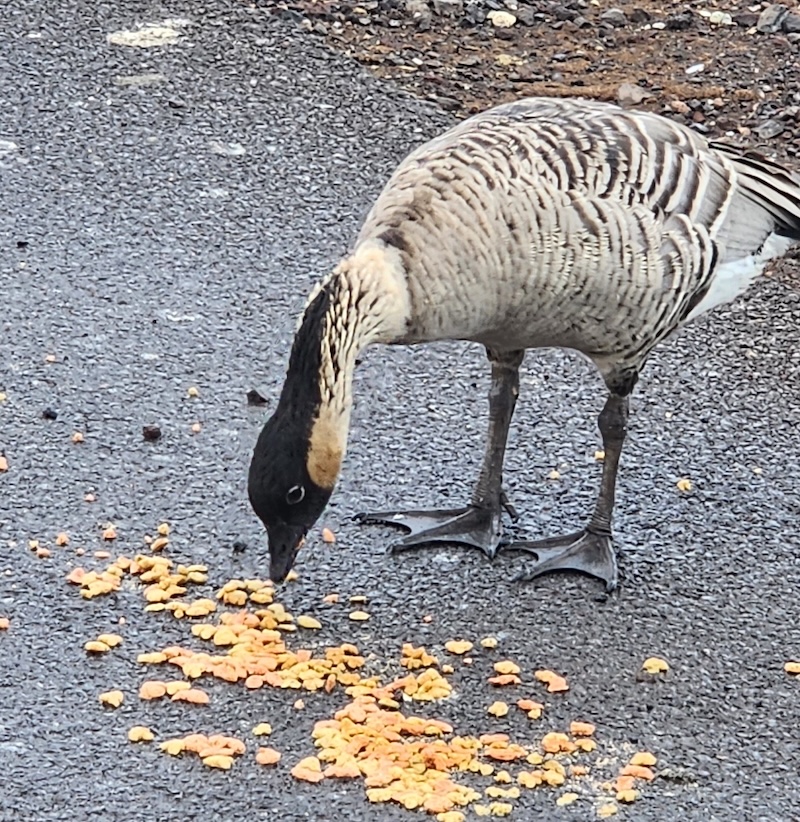
This nēnē may get sick from eating cat food dumped on the ground by feral cat feeders. It may also contract toxoplasmosis or be attacked by the cats.
Be pono near nēnē: follow the “Five Keeps”
Our mascot at DLNR Forestry & Wildlife is Pono the Nēnē, who helps us learn how to be pono when engaging with nature. We have videos (and stickers!) of Pono the Nēnē on our Be Pono Outdoors webpage. For nēnē, one way to remember pono behaviors is to practice the “Five Keeps”:
- Keep your food to yourself. Feeding any birds or feral animals is not a kind act: it teaches birds like nēnē to come to cars, roads and close to our homes where they can be killed. There is plenty of food and water for native birds, and their natural grinds are much better for them than foods we humans eat. Nēnē can also be put at risk when people leave food outside for other animals, like feral cats. Donʻt feed nēnē, don’t feed feral cats, and don’t leave pet food outside.
- Keep your dogs on a leash. Even the best-behaved dogs can threaten or kill these birds, and all Hawai‘i counties have leash laws.
- Keep your cats inside your house. Even fed cats still practice hunting and can kill goslings. Toxoplasmosis from cat poop spreads to other animals, including nēnē, and can kill them.
- Keep your speed down when you see a nēnē near a road. Our paved roads look just like pāhoehoe lava flows to a nēnē – the perfect place to get your feet warm on a cold morning. Large birds like nēnē need a long runway for take-off and can’t instantly jump into the air to dodge a speeding car.
- Keep your distance. These are wild animals with their own lives to lead. Approaching for a selfie could push them into a road, keep them from eating, or drive them from a nest.
Learn more about nēnē
 Nēnē: A Recovery Story
Nēnē: A Recovery Story
Nēnē Recovery Timeline: Summary version | Detailed version
Plans & Projects
Photos
Additional Resources
For more information and references, visit the DLNR State Wildlife Action Plan factsheets & A Teacher’s Guide to Nēnē. DOFAWʻs species pages and State Wildlife Action Plan fact sheets are provided for general information and are not meant to be a citable, original source of data. If you are a student, researcher, or writer looking for a citable source, please explore the references below or find other original data sources, rather than citing these webpages. The references below were provided by the authors of the State Wildlife Action Plan fact sheets at the time of drafting:
- Banko PC, Black JM, Banko WE. 1999. Hawaiian goose (Branta sandvicensis). In The Birds of North America, No. 434 (Poole A, Gill F, editors). Philadelphia, (PA): The Academy of Natural Sciences; and Washington DC: The American Ornithologists’ Union.
- State of Hawai‘i, Department of Land and Natural Resources, Division of Forestry and Wildlife. 2014. Kaua‘i Nēnē Relocation Project: December 2014 Project Update.
- U.S. Fish and Wildlife Service. 2004. Draft revised recovery plan for the Nene or Hawaiian Goose (Branta sandvicensis). U.S. Fish and Wildlife Service, Portland, OR. 148 + xi pp.
- U.S. Fish and Wildlife Service. 2011. Nene or Hawaiian goose (Branta sandvicensis) 5-year review: summary and evaluation. U.S. Fish and Wildlife Service, Honolulu, HI.
- VanderWerf, EA. 2012. Hawaiian Bird Conservation Action Plan. Pacific Rim Conservation, Honolulu, HI.
- Work, T., J. Dagenais, R. Rameyer, and R. Breeden. 2015. Mortality patters in endangered Hawaiian Geese (Nēnē, Branta sandvicensis). Journal of Wildlife Diseases. Vol. 51, Issue 3, pg(s) 688-695 doi: 10.7589/2014-11-256


